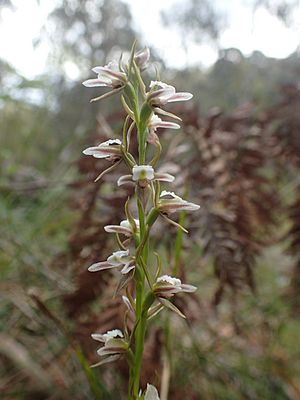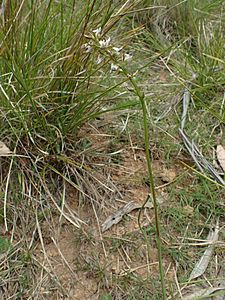Prasophyllum basalticum facts for kids
Quick facts for kids Prasophyllum basalticum |
|
|---|---|
 |
|
| Prasophyllum basalticum flowers | |
| Scientific classification |
Prasophyllum basalticum is a special type of orchid that only grows in New South Wales, Australia. It has a single, dark green leaf shaped like a tube. This plant can have up to fifteen flowers that smell sweet. Their colors range from greenish-brown to brownish-red. Each flower has a white and green part called a labellum. You can find this orchid growing in grassy woodlands on the Northern Tablelands.
What This Orchid Looks Like
Prasophyllum basalticum is a plant that grows from the ground. It is a perennial plant, meaning it lives for more than two years. It is also deciduous, so it sheds its leaves at certain times. This plant has a special underground part called a tuber, which stores food.
It grows a single, dark green leaf that looks like a tube. This leaf can be about 200 millimetres (7.9 in) to 350 millimetres (14 in) (8 to 14 inches) long. It is about 3 millimetres (0.12 in) to 5 millimetres (0.20 in) (0.1 to 0.2 inches) wide. The bottom part of the leaf is often purplish.
The Flowers
This orchid produces a tall stem, about 70 millimetres (2.8 in) to 150 millimetres (5.9 in) (3 to 6 inches) high. On this stem, you will find between five and fifteen flowers. The flowers are greenish-brown to brownish-red and have a sweet smell.
Like other orchids in its group, these flowers are upside down. This means the labellum (a special lip-like part) is at the top instead of the bottom.
Flower Parts
The dorsal sepal is a part of the flower that is narrow and egg-shaped. It is about 8 millimetres (0.31 in) to 10 millimetres (0.39 in) (0.3 to 0.4 inches) long and 3 millimetres (0.12 in) (0.1 inches) wide. It has three thin, dark lines.
The lateral sepals are long and narrow, about 8 millimetres (0.31 in) to 10 millimetres (0.39 in) (0.3 to 0.4 inches) long. They are about 2 millimetres (0.079 in) (0.08 inches) wide and are slightly curved.
The petals are white with a reddish line down the middle. They are also long and narrow, about 8 millimetres (0.31 in) to 10 millimetres (0.39 in) (0.3 to 0.4 inches) long and 2 millimetres (0.079 in) (0.08 inches) wide.
The labellum is white and shaped like an oblong. It is about 8.5 millimetres (0.33 in) to 10.5 millimetres (0.41 in) (0.33 to 0.41 inches) long and 4 millimetres (0.16 in) (0.16 inches) wide. This part sharply bends upwards and backwards. In the middle of the labellum, there is a green, egg-shaped area called a callus. This callus extends a little past the bend.
This orchid usually flowers in November and December.
How It Got Its Name
The scientific name Prasophyllum basalticum was first officially described in 2018. Two botanists, David Jones and Lachlan Copeland, gave it this name. They described it from a plant found in Werrikimbe National Park. Their description was published in a magazine called Australian Orchid Review.
The second part of its name, basalticum, comes from the Latin word basaltes. This word means "basalt," which is a type of dark rock. This name was chosen because this orchid usually grows in soils that come from basalt rock.
Where It Lives
This type of leek orchid grows in grassy woodlands. It can be found at high places, between 700 metres (2,300 ft) and 1,550 metres (5,090 ft) (about 2,300 to 5,000 feet) above sea level. You can find it in areas like Barrington Tops, Ebor, and Dorrigo districts.


